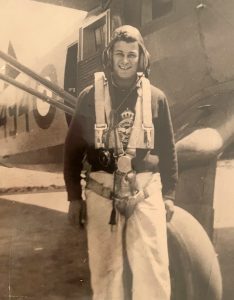
His original itinerary involved a flight from Canada to Israel, but when Harvey Engelberg received a letter of inquiry from France, a few weeks ago, his plans changed. Thérèse Férey and her husband, current owners of a farm in Normandy, wondered if Harvey was related to one Cobby Engelberg, a Canadian airman shot down in the early hours of June 6, 1944.
When Harvey explained that Cobby was his father, he changed his flight plans to include a side trip to Normandy.
“I own a farm in Bassenville,” Mme Férey wrote in her letter, “and we’ve found pieces of (your father’s) plane that crashed on our property. Would you like them?”
“My head exploded,” Harvey told CJN Daily podcast host Ellin Bessner this week.

When he met the Féreys, they took him to the site. Nearly 78 years to the day, Cobby Engelberg (then 24) was serving as a wireless radio operator in an RCAF Dakota aircraft transporting British paratroops to prevent a German counteroffensive when Allied forces landed on the Normandy beaches on D-Day.
But the Dakota was hit by flack. Everybody got out of the burning transport but pilot Harvey Jones and Cobby Engelberg. Jones crash-landed the plane, but died, while Engelberg survived severely injured.
The former owners of the farm hid Engelberg until a passing Allied patrol helped get the injured airman back to England. CJN Daily host Bessner asked Harvey if he planned to keep the pieces of his dad’s Dakota airplane.
“I have my father’s dog tag,” Harvey said, but he’s giving all 42 pieces of the Dakota aircraft to the Juno Beach Centre, Canada’s D-Day museum in Courseulles-sur-Mer, France. “They’ll do a better job of preserving them for the future. Otherwise they’d sit in one of our drawers and be forgotten.”
Harvey Engelberg’s strong sense of preserving history is commendable, but not as common as one would hope.
When I researched my book about the Canadian airmen flying the famous Dam Buster raid against the River Ruhr dams of 1943, I learned that relevant documents were lost. They’d been stolen by someone purporting to be a historian.

In this case, a British collector named Alex Bateman had approached the widow of Dam Buster John Fraser asking to “borrow” his flight log. When a trusting Doris Fraser obliged, she never saw the artifact again. Bateman later went to jail for the theft (and likely sale on the black market).
The log has never been found – an emotional piece of a family’s past and a vital piece of the world’s history gone forever.
In contrast, when the family of another member of the Canadian Dam Busters veteran, Torger Taerum, was approached by the Bomber Command Museum of Canada in Nanton, the surviving Taerum family recognized the value of contributing family heirlooms for posterity. They chose to donate Taerum’s uniform, flight log and medals to the BCMC and ultimately the public good.
“Helen Robertson (Terum’s cousin) told the museum … she was convinced Taerum’s medals belonged in the museum,” a museum spokesman said.

Coincidentally, I read this week about another Canadian museum and its treatment of highly valuable artifact. Samantha Thompson, the archivist for the Peel Art Gallery in Brampton, recently received a donation.
It was a scroll of paper containing a memoir of Standing Bear, a member of the Lakota First Nation who’d witnessed the Battle of Little Bighorn (a.k.a. Custer’s Last Stand) in 1876. Thompson recognized its incredible material value, but had second thoughts.
“There’s no question that repatriation was the right thing to do,” Thompson told journalist Elaine Smith. “These documents (are) much more important to the community where they came from.”
And so today the scroll is featured prominently at the Journey Museum and Learning Center in Rapid City, on the Pine Ridge Reservation in South Dakota
“The documents will speak to the world more clearly through (the Lakota First Nation).”
When Harvey Engelberg visited the farm where his father’s wartime airplane crashed and burned in 1944, he was overwhelmed by the experience. More remarkable, when he learned that the original wartime farmers – who saved his father Cobby Engelberg from the wreck – then faced German retribution (the Nazis executed their 16-year-old son), he acknowledged a personal debt.
Their courage saved an Allied airman’s life. It assured Harvey Engelberg his life. And when Harvey donated the airplane fragments to Juno Beach Centre, that gesture meant we all could all learn about selfless sacrifice.
“Even though it would be nice to have those pieces, they’re for the world to see,” Harvey Engelberg told CJN Daily. “The (pieces) are too important to be selfish about them.”